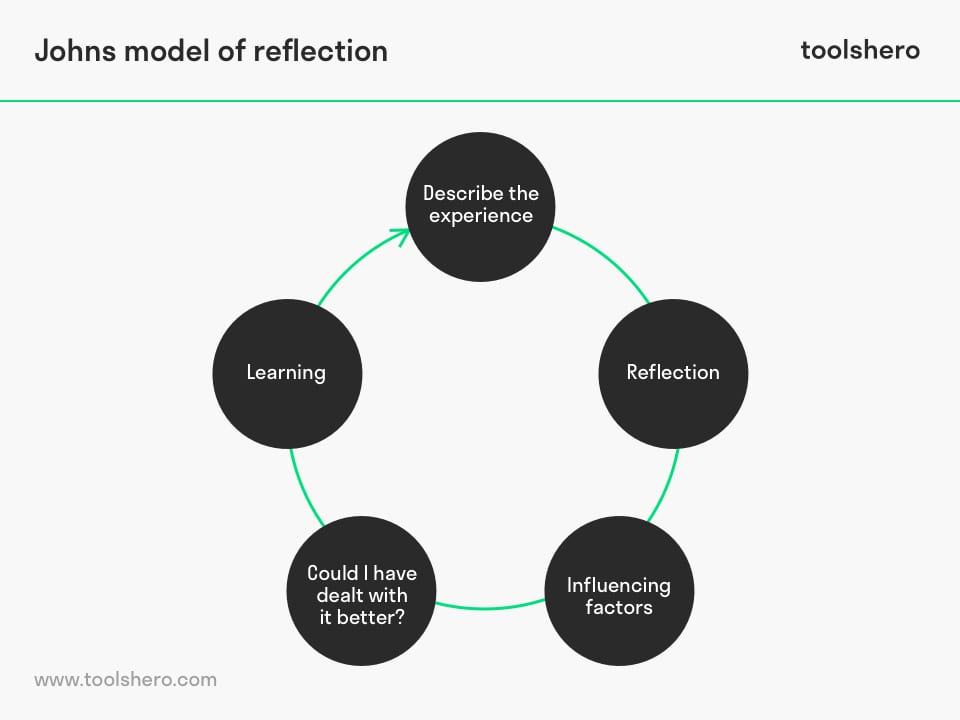Johns Model of Reflection explained

Johns Model of Reflection: this article provides a practical explanation of Johns Model of Reflection. This article contains the definition of Johns Model of Reflection, an example in healthcare and a step-by-step plan to start yourself. After reading this article, you’ll understand the basics of this experiential learning and reflective practice tool. Enjoy reading!
What is Johns Model of Reflection?
The Johns Model of Reflection (MSR) is a model for structured reflection by Christopher Johns. The model was originally developed for the nursing sector at the Burford Nursing Development Unit, in the early nineties.
However, the Johns Model of Reflection was soon adopted in several other sectors as well. He viewed this model as an essential part of the process of structured reflection.
The model was inspired by the research Johns conducted in which he observed the dialogue between practitioners of a profession and their supervisors. The model can help to reflect on and analyse complex decision making but can also be useful in learning to critically reflect.
He focused on discovering knowledge that is used in practice and to make this explicit. The framework that Johns developed consists of five cue questions that are subsequently divided into more detailed questions to advance reflection.
Johns suggested that one should have an internal and external focus while thinking. An internal focus refers to one’s own emotions and thoughts, and an external focus means to consider the factual situation or incidents. This is done by answering the cue questions that belong to each phase.
What is critical reflection?
Critical reflection enables people to synthesise different perspectives (or ideas, opinions, etc.) to help explain what we encounter in everyday life. It’s possible that a theory or literature offers a perspective that must be considered, can provide proof to support ideas or challenge these explicitly.
Additionally, critical reflection posits that people are able to analyse what was learnt and how this was learnt. This learning style is essential to gain control over one’s own development.
For the above-mentioned reasons, critical reflection is deemed to be of great importance, particularly in the professional development of teachers: they ready youngsters for their professional careers.
What is a critical analysis?
To profit from the use of the Johns model of reflection as much as possible, it’s important to understand what critical analysis entails. A critical analysis concerns both critical thinking and conducting the analysis.
An analysis is the process in which a complex subject or problem is divided into smaller parts to get a clearer view. An example of this is investigating the reasons why students fail to understand certain concepts.
A non-analytical approach could show that the students simply weren’t ready to learn about such a complex subject. A more critical analytical approach, however, could demonstrate that there are several factors that influence the students’ inability to understand the subject.
Examples of such reasons include:
- The context of the lesson wasn’t clear
- The way the teacher evaluates the students’ understanding
Critical thinking is in fact a skeptical or inquiring approach to knowledge. Someone who often thinks critically will doubt assumptions and look at a problem from different perspectives.
Critical analysis is mostly concerned with setting aside personal opinions and values when considering information or ideas. Subsequently, evidence to define the investigated problem must be sought.
Phases and step-by-step plan of structured reflection of Christopher Johns
The step-by-step plan below can be used by everyone who wants to critically reflect on what he/she is doing in daily life, based on Johns’ model of reflection. Depending on the situation and context in which this tool can be used, certain questions may be more or less relevant.

Figure 1 – Johns Model of Reflection
Phase 1: describe the experience
The first phase concerns describing the situation. This is done by answering several questions. Use the questions below to support the reflection.
Phenomenon
Describe the experience you’re feeling and living right now.
Casual
What essential factors contributed to this experience?
Context
What significant background factors belong to this experience?
Explain
What are the key processes for reflection during this experience?
Phase 2: reflection
The second phase is about the reflection itself. Answer the following questions:
- What am I trying to achieve?
- Why did I approach this the way I did?
- What were the consequences of my actions for me?
- What were the consequences of my actions for the patient? My family?
- What were the consequences of my actions for the people I work with?
- How did I feel during this experience?
- How did others feel during this experience?
- How do I know how others felt during this experience?
Phase 3: influencing factors
The third phase revolves around the factors that influenced the situation as it occurred. Answer the following questions as part of Johns’ model of reflection:
- What internal factors influenced my decision making during the experience?
- What external factors influenced my decision making during this experience?
- What sources of knowledge were available?
- What sources could I have consulted?
- What sources and information would have impacted my choice?
Phase 4: what could I have done better
The fourth phase concerns identifying improvement areas for the situation as it occurred. Answer the following questions:
- What other options did I have?
- What consequences are involved in the other options?
- Have I considered all options?
- Have I selected the best option?
Phase 5: learning
The fifth phase is about learning from areas for improvement as identified in the previous phase. Answer the following questions:
- What will change because of this experience?
- How do I feel about my experience now?
- Does this situation have to do with past situations?
- What would have been a better way to approach this situation?
- What are the consequences of alternatives choices I’ve made for patients? For others and for me?
- How approachable and available am I to better help my patients and colleagues?
- How has this experience changed my knowledge? In one of the following ways:
- Empirical – scientific
- Ethical – moral knowledge
- Personal – self-awareness
- Aesthetic – the art of what we do, our own experiences
Johns Model of Reflection example in healthcare
It’s not surprising that Johns Model of Reflection arose in the nursing profession. In frontlines such as hospitals and nursing homes, nurses fulfil a crucial role in seeing to the needs concerning patients’ physical and mental wellbeing. In these institutions, reflective working is very important for various reasons.
Scientific research by Oelofsen, Somerville and Keeling shows that reflective practices at work advance the development of skills such as awareness and the ability to influence others. Working reflectively ensures that people gain insight into pratical events and how someone’s own approach and history has contributed to the way situations arose and how these were handled.
Translated to the physical workplace of many nurses, the Johns model of reflection can be summarised in three steps:
1. Curiosity
The process starts by noticing things, asking the right questions, and questioning assumptions. In the first step, nurses and other professionals ask the questions that help them understand the situation that must be reflected upon. Answer the following questions for this purpose:
- What really happened?
- Why was the situation handled as it was?
- What else could have happened?
- What more can happen now?
- What do I think of this situation?
- How has the situation affected me?
- What was the situation’s influence on others? The team?
2. Take a closer look
The second step is concerned with actively working on the questions from step 1. Reflective professionals do what is needed to find out more about the patient, themselves, colleagues and information. They also zoom in on their own experiences and feelings and can slow down their own thoughts and actions for further contemplation.
In this step, reflective professionals try to find ways to articulate the phenomena from step 1 and to become aware of all underlying assumptions that lie at the foundation of their own practices and actions.
3. Transformation
The third and final phase revolves around converting feedback into action. Through observations gained during the first phase in combination with the observations from step 2, the transformation phase is about finding a way to design the process in such a way that it facilitates positive change.
The goal of this phase is to take action that leads to better methods and eventually better service.
Johns Model of Reflection: aspects of reflection
As you’ve read, a critical reflective cycle is particularly important for teachers. Teaching is a complex activity during which decisions are made in complex contexts. Reflective practices are generally considered to be an important activity for professional development.
There is a great deal of literature and studies available that discuss the importance of reflection and reflective practices, i.e. the Gibbs Reflective or John Driscoll Model of Reflection. There are important characteristics of reflection that are generally supported by each of these studies.
- Reflection results in learning. This is due to changing ideas, but also a changing understanding of the situation
- Reflection is an active learning process, and is more than simply thinking
- Reflection is not a linear process, it is cyclical, where reflection leads to the development of new ideas or opinions that are used to plan the next learning phases
- Reflection encourages one to view problems from as many perspectives as possible. This helps to properly understand the issue and to investigate personal values, assumptions and ideas.
Therefore, critical reflection refers to a combination of analytical, inquisitive or reflective approaches. A critically reflective conversation is thus characterised by a combination of these factors.
Implementing Johns Model of Reflection on the work floor
Employees of all types of companies are regularly asked to improve and demonstrate their abilities in the field of critical reflection.
This can be quite complex, particularly as little guidance is offered. Below, you can find several tools and methods that are frequently used in developing the ability for critical reflection.
- Learning sheets, blogs, studies, articles
- Portfolios
- Written assessment tasks regarding predetermined points
- Meetings with tutor/ mentor
Regardless of the size or subject of these reflection methods, they all enable the user to reflect on a deep level.
Johns Model of Reflection: critical reflection and transformational learning
Mezirow, among others, posited that reflection only leads to learning when it generates transformation. Additionally, Mezirow suggested that transformation only takes place where the original starting point of a dilemma must be addressed. If that’s the case, several phases are completed:
- A dilemma that creates disorientation: loss of a job, divorce, going back to school, move, emigrating, a marriage that ends, etc.
- Self-investigation with feelings of anger, fear, shame or guilt
- Critical assessment of assumptions
- Acknowledging someone’s dissatisfaction
- Exploring new options for relationships, actions or roles
- Plotting a course
- Acquiring knowledge and skills for implementing new plans
- Preliminary testing of new roles
- Building competence and self-confidence in new relationships, actions and roles
- Reintegration into someone’s life based on new circumstances that are imposed by a new perspective or adopting new views
What is striking about Mezirow’s ideas is the emphasis on conscious, self-guided learning. This learning is not a direct result of an experience, but rather results from the individual taking charge of critical reflection and explicitly planning new steps to learn from.
Now it’s your turn
What do you think? Do you recognise the explanation of the Johns Model of Reflection? Do you believe it’s important to reflect regularly? Do you train your critical thinking? Do you believe that reflection methods should form a fixed part of Human Resource Management? Do you have any tips or additional comments about this theory?
Share your experience and knowledge in the comments box below.
More information
- Johns, C. (1995). Framing learning through reflection within Carper’s fundamental ways of knowing in nursing. Journal of advanced nursing, 22(2), 226-234.
- Johns, C. (1996). Visualizing and realizing caring in practice through guided reflection. Journal of Advanced Nursing, 24(6), 1135-1143.
- Johns, C. (1999). Reflection as empowerment?. Nursing Inquiry, 6(4), 241-249.
- Johns, C. (2009). Guided reflection: Advancing practice. John Wiley & Sons.
- Johns, C., & Freshwater, D. (Eds.). (2009). Transforming nursing through reflective practice. John Wiley & Sons.
- Johns, C. (Ed.). (2017). Becoming a reflective practitioner. John Wiley & Sons.
How to cite this article:
Janse, B. (2020). Johns Model of Reflection. Retrieved [insert date] from Toolshero: https://www.toolshero.com/personal-development/johns-model-of-reflection/Original publication date: 03/14/2020 | Last update: 12/17/2023
Add a link to this page on your website:
<a href=”https://www.toolshero.com/personal-development/johns-model-of-reflection/”>Toolshero: Johns Model of Reflection</a>













